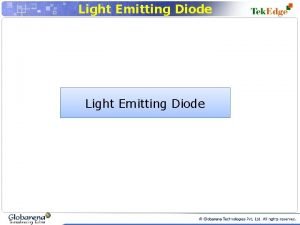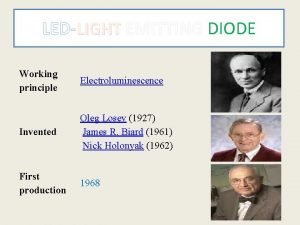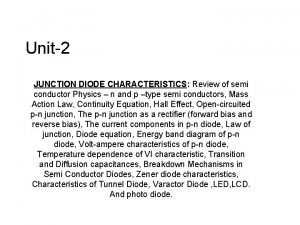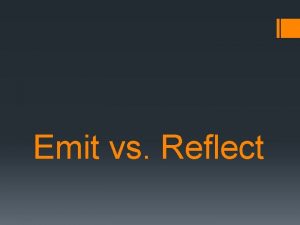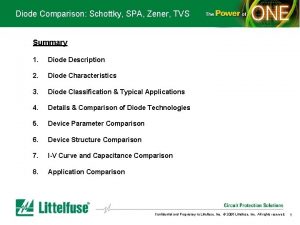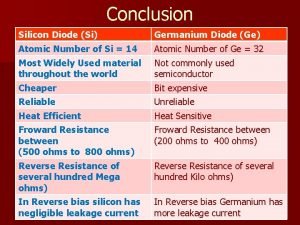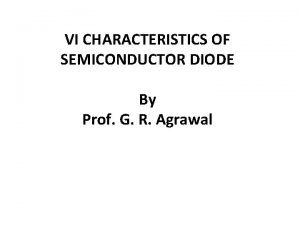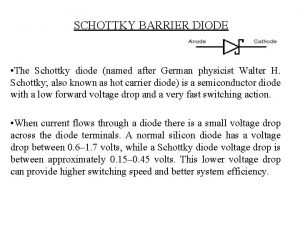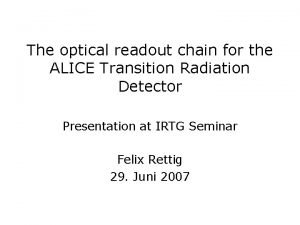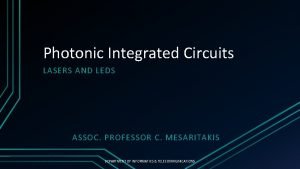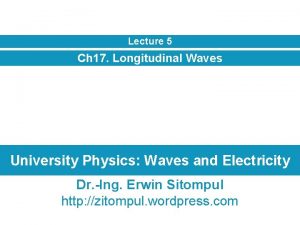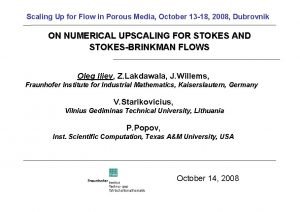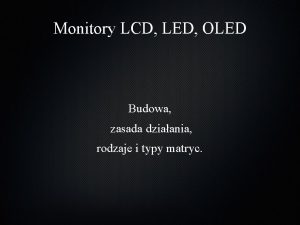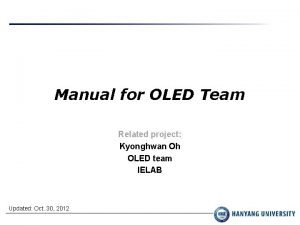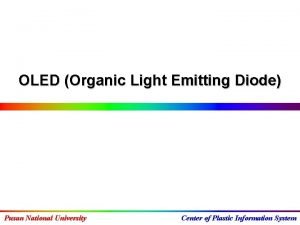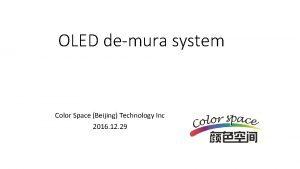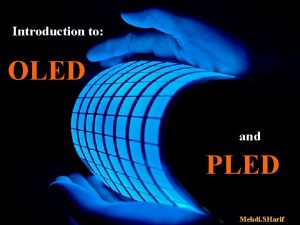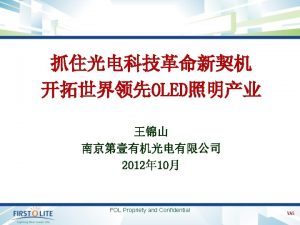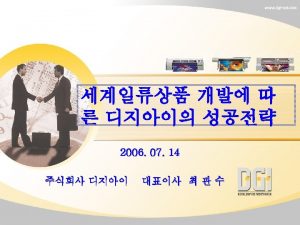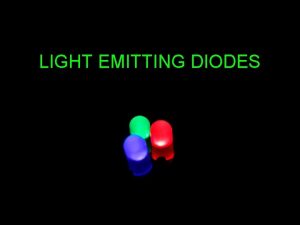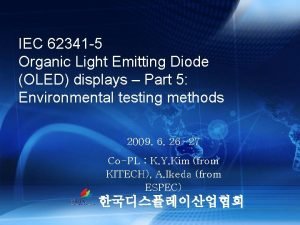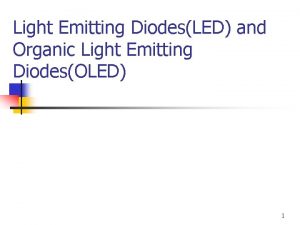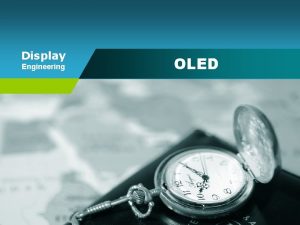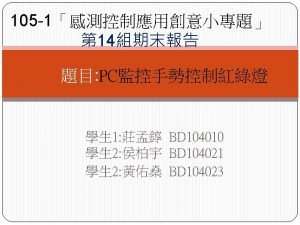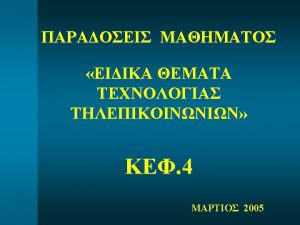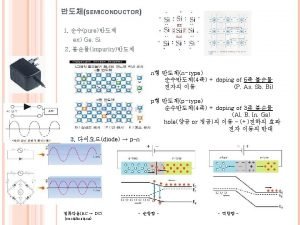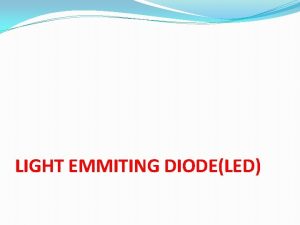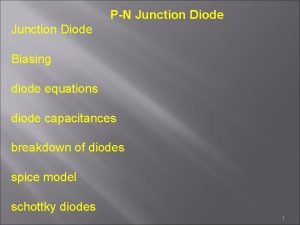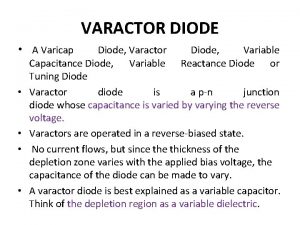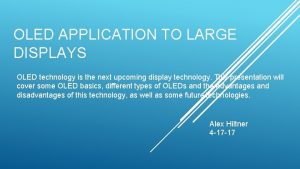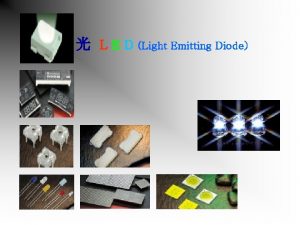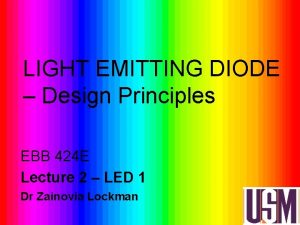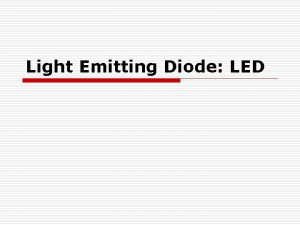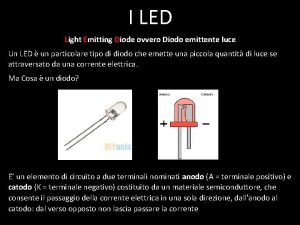OLED ORGANIC LIGHT EMITTING DIODE DISPLAY TECHNOLOGY Jay






![[A] Classification according to Organic Material used 1. SMALL MOLECULE OLEDs: • First developed [A] Classification according to Organic Material used 1. SMALL MOLECULE OLEDs: • First developed](https://slidetodoc.com/presentation_image_h/1042a27ada4535eb90caebfadd153d02/image-7.jpg)
![[B] Classification according to Transparency 1. Bottom or top emissive OLEDs: • One of [B] Classification according to Transparency 1. Bottom or top emissive OLEDs: • One of](https://slidetodoc.com/presentation_image_h/1042a27ada4535eb90caebfadd153d02/image-8.jpg)
![[B] Classification according to Transparency 2. Transparent OLEDs: • Both electrodes are kept transparent [B] Classification according to Transparency 2. Transparent OLEDs: • Both electrodes are kept transparent](https://slidetodoc.com/presentation_image_h/1042a27ada4535eb90caebfadd153d02/image-9.jpg)
![[C] FOLDABLE OLED • Flexible substrate is used • It is prepared by roll-to-roll [C] FOLDABLE OLED • Flexible substrate is used • It is prepared by roll-to-roll](https://slidetodoc.com/presentation_image_h/1042a27ada4535eb90caebfadd153d02/image-10.jpg)
![[C] FOLDABLE OLED q FOLEDs offer Revolutionary Features for Display: 1. Flexibility 2. Ultra-lightweight, [C] FOLDABLE OLED q FOLEDs offer Revolutionary Features for Display: 1. Flexibility 2. Ultra-lightweight,](https://slidetodoc.com/presentation_image_h/1042a27ada4535eb90caebfadd153d02/image-11.jpg)
![[D] CLASSIFICATION ACCORDING TO PIXEL FORMATION USED 1. Active Matrix OLEDs (AM-OLEDs): § Display [D] CLASSIFICATION ACCORDING TO PIXEL FORMATION USED 1. Active Matrix OLEDs (AM-OLEDs): § Display](https://slidetodoc.com/presentation_image_h/1042a27ada4535eb90caebfadd153d02/image-12.jpg)
![[D] CLASSIFICATION ACCORDING TO PIXEL FORMATION USED 2. Passive Matrix OLEDs (PM-OLEDs): § Cathode [D] CLASSIFICATION ACCORDING TO PIXEL FORMATION USED 2. Passive Matrix OLEDs (PM-OLEDs): § Cathode](https://slidetodoc.com/presentation_image_h/1042a27ada4535eb90caebfadd153d02/image-13.jpg)











- Slides: 24

OLED ORGANIC LIGHT EMITTING DIODE DISPLAY TECHNOLOGY Jay Dhamsaniya Rakesh Adroja Department of E & C Engineering Institute of Technology Nirma University Ahemedabad OCT - 2011

Definition : An organic light emitting diode (OLED) is a light-emitting diode (LED) in which the emissive electroluminescent layer is a film of organic compounds that emits light when an electric current passes through it.

§ 2 – layer structure § Active & In-active condition § Material used in layer o Anode (+) Indium tin oxide (ITO) o Cathode (-) Metals such as aluminium (Al) and calcium (Ca) o Emissive layer Alq 3 which emits radiation in the range of green light o Conductive layer Diamine

§ For efficient emission recombination zone should be in the middle of the organic emissive layer § In organic semiconductors, holes are mobile than electrons § Recombination happens closer to the emissive layer § Problem solution : Multi layer structured OLED

Electron-hole recombination zone is shifted in the middle of the emissive layer

OLED Organic material used Transparency Foldable OLED Pixel Formation used Small Molecule OLED Bottom or Top emitting OLED Active Matrix OLED Polymer OLED Transparent OLED Passive Matrix OLED Phosphorescent OLED Stacked OLED Inverted OLED White OLED
![A Classification according to Organic Material used 1 SMALL MOLECULE OLEDs First developed [A] Classification according to Organic Material used 1. SMALL MOLECULE OLEDs: • First developed](https://slidetodoc.com/presentation_image_h/1042a27ada4535eb90caebfadd153d02/image-7.jpg)
[A] Classification according to Organic Material used 1. SMALL MOLECULE OLEDs: • First developed at Eastman Kodak by Dr. Ching W. Tang • Example: Alq 3 2. POLYMER MOLECULE OLEDs: • Example: poly(p-phenylene vinylene) 3. PHOSPHORESCENT MATERIALS OLEDs: • Example: Ir(mppy)3, • It is a phosphorescent dopant which emits green light
![B Classification according to Transparency 1 Bottom or top emissive OLEDs One of [B] Classification according to Transparency 1. Bottom or top emissive OLEDs: • One of](https://slidetodoc.com/presentation_image_h/1042a27ada4535eb90caebfadd153d02/image-8.jpg)
[B] Classification according to Transparency 1. Bottom or top emissive OLEDs: • One of the electrode is kept transparent
![B Classification according to Transparency 2 Transparent OLEDs Both electrodes are kept transparent [B] Classification according to Transparency 2. Transparent OLEDs: • Both electrodes are kept transparent](https://slidetodoc.com/presentation_image_h/1042a27ada4535eb90caebfadd153d02/image-9.jpg)
[B] Classification according to Transparency 2. Transparent OLEDs: • Both electrodes are kept transparent
![C FOLDABLE OLED Flexible substrate is used It is prepared by rolltoroll [C] FOLDABLE OLED • Flexible substrate is used • It is prepared by roll-to-roll](https://slidetodoc.com/presentation_image_h/1042a27ada4535eb90caebfadd153d02/image-10.jpg)
[C] FOLDABLE OLED • Flexible substrate is used • It is prepared by roll-to-roll patterning method
![C FOLDABLE OLED q FOLEDs offer Revolutionary Features for Display 1 Flexibility 2 Ultralightweight [C] FOLDABLE OLED q FOLEDs offer Revolutionary Features for Display: 1. Flexibility 2. Ultra-lightweight,](https://slidetodoc.com/presentation_image_h/1042a27ada4535eb90caebfadd153d02/image-11.jpg)
[C] FOLDABLE OLED q FOLEDs offer Revolutionary Features for Display: 1. Flexibility 2. Ultra-lightweight, thin form 3. Durability 4. Cost-effective processing
![D CLASSIFICATION ACCORDING TO PIXEL FORMATION USED 1 Active Matrix OLEDs AMOLEDs Display [D] CLASSIFICATION ACCORDING TO PIXEL FORMATION USED 1. Active Matrix OLEDs (AM-OLEDs): § Display](https://slidetodoc.com/presentation_image_h/1042a27ada4535eb90caebfadd153d02/image-12.jpg)
[D] CLASSIFICATION ACCORDING TO PIXEL FORMATION USED 1. Active Matrix OLEDs (AM-OLEDs): § Display is a set of pixel § Pixel is a single oled § Individual Cathode and Anode § Biasing current provided to pixel, is controlled by TFT according to information § A/D: Reduces power consumption § D/A: Patterning/Fabrication cost is high
![D CLASSIFICATION ACCORDING TO PIXEL FORMATION USED 2 Passive Matrix OLEDs PMOLEDs Cathode [D] CLASSIFICATION ACCORDING TO PIXEL FORMATION USED 2. Passive Matrix OLEDs (PM-OLEDs): § Cathode](https://slidetodoc.com/presentation_image_h/1042a27ada4535eb90caebfadd153d02/image-13.jpg)
[D] CLASSIFICATION ACCORDING TO PIXEL FORMATION USED 2. Passive Matrix OLEDs (PM-OLEDs): § Cathode and Anode are kept common for each rows/columns § Pixel formed at the intersection

q Advantages: 1. Very thin panel of approximately 1 mm 2. Low power consumption 3. High brightness 4. High contrast ratio of 10, 000 : 1 5. Wide viewing angle of 170 6. No environmental drawbacks 7. Foldable display panel

q Advantages of OLED Display over TFT-LCD Display: 1. Contrast Ratio § Higher contrast ratio than TFT-LCD display § Better impression for higher brightness Contrast Ratio (Sunlight Readable) Condition OLED TFT-LCD Dark room > 10, 000 : 1 300 : 1 Rainy 400 130 Cloudy 190 10 Sunlight 50 4

2. Viewing Angle § Higher viewing angle up to 170 for constant contrast ratio § Graph: contrast V/S viewing angle

3. Response Time § Fast time response in order of <50 us § Comparison by graphical point of view

4. Backlight Function § No backlight required in OLED display § During black background OLED is turned OFF § In LCD backlight is still required

4. Power Efficiency § OLED display is more power efficient than TFT-LCD display § For the same power OLED display is more brighter

1. Limited life time 2. Color balancing issues 3. Water damage 4. Power consumption


§ Light weight § Thin § Unbreakable § Low cost processing potential for Roll-to-Roll patterning § New product possibility

There are many other opportunities for application of organic thin-film semiconductors and challenges are remain for development that is shown following table. Challenges Opportunities Matireals blue & white EL, low-cost ITO alternatives Process cost high OLED Industry still in the early stage of development Driving Tech for AMOLED is still under development White OLED high performance WOLED is needed Solution Printing tech is viable for large size and low cost FOLED will be very attractive for application in conformal, fordable or even flexible lighting and displays

Thank you!
 Construction of light emitting diode
Construction of light emitting diode Led working principle
Led working principle Band diagram pn junction
Band diagram pn junction Emit vs reflect light
Emit vs reflect light Tvs diode vs zener
Tvs diode vs zener Conclusion for forward and reverse bias
Conclusion for forward and reverse bias Difference between pn junction diode and zener diode
Difference between pn junction diode and zener diode Schottky diode definition
Schottky diode definition Light light light chapter 23
Light light light chapter 23 Into the light chapter 22
Into the light chapter 22 Light light light chapter 22
Light light light chapter 22 Vertical cavity surface emitting laser
Vertical cavity surface emitting laser Laser coherence
Laser coherence An ambulance with a siren emitting a whine at
An ambulance with a siren emitting a whine at Difference between random scan and raster scan
Difference between random scan and raster scan In raster scan display the frame buffer holds
In raster scan display the frame buffer holds Raster scan display and vector scan display
Raster scan display and vector scan display Continuity equation
Continuity equation Matryca lcd budowa
Matryca lcd budowa Oled crosstalk
Oled crosstalk Plastic oled
Plastic oled Mura oled
Mura oled Oled introduction
Oled introduction Oled 照明
Oled 照明 Oled inkjet
Oled inkjet
